Walk with me. Imagine late July at Alderfer Park in Evergreen Colorado, at 7800' in the Rocky Mountains. The morning was turning hot, but was still pleasant.
 |
| Start of the trail |
The meadow was part of a ranch before it became a Colorado park, so most of the grasses, tall in this year's rain, were introduced to feed the livestock. But between them, there were lots of native wildflowers:
 |
| Wildflowers in the grass: the purple is purple locoweed, Oxytropis lambertii, the gray leaves are fringed sage, Artemisia frigida, the intense blue a larkspur (Delphinium). |
 |
| View across the meadow |
Many of the white flowers in the picture below are sego lilies also called Gunnison's mariposa lily (Calychortus gunnisonii) in the lily family, Liliaceae. The name mariposa is Spanish for butterfly, sego is a Shoshonean language word for "edible bulb." (Read the history of a closely-related species of sego lily which is Utah's state flower link).
 |
| Sego lilies and asters amid the grass |
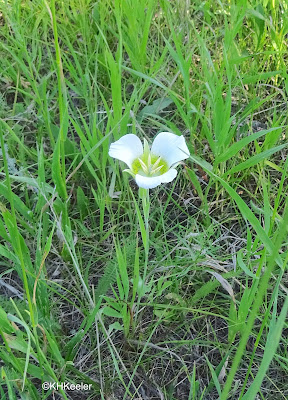 |
| sego lily Calychortus gunnisonii |
A goldenrod, likely Solidago missouriensis (sunflower family, Asteraceae). You know it is midsummer when the goldenrods flower. There are 77 species of goldenrod in North America. All across the continent, there will be some near you, maybe not the same ones as in central Colorado.
 |
| goldenrod |
The meadow continued until it met the forest.
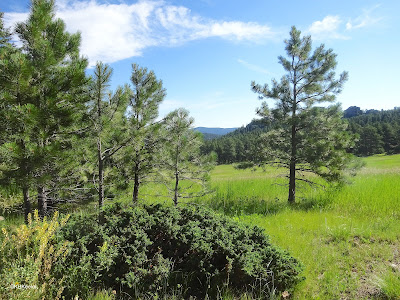 |
There we walked in shade, admiring wildflowers.
Where I live, 3000 feet lower, sulphur flower (Eriogonum umbellatum, buckwheat family Polygonaceae) is no longer blooming, but these (below) were.
The wax currants (Ribes cereus, gooseberry family Grossulariaceae) were heavy with bright red fruit (see below). All 13 species of currants, also called gooseberries, in Colorado have edible fruit but some taste better than others. Wax currants are generally panned by writers of edible native plant books and I have never been impressed by the ones I've tasted.
 |
| sulphur flower, Eriogonum umbellatum |
Growing under the forest on shallow soils over rocks, were lanceleaf stonecrops (Sedum lanceolatum, stonecrop family Crassulaceae). They were common and easy to see. But so beautiful! I never tired of discovering another one. (Close up below)
 |
| spearleaf stonecrop Sedum lanceolatum |
 |
| spearleaf stonecrop Sedum lanceolatum |
Initially I bypassed this little plant (below), because it seemed to be done flowering and going to seed. I think it is wand phacelia, Phacelia heterophylla in the waterleaf family, Hydrophyllaceae. But I kept seeing bees flying to it--there's one on the left group of flowers in the photo)--so I looked more closely and, yes, most plants had one or more whitish-green flowers open. They certainly attracted bees and bumblebees.
 |
| wand phacelia, Phacelia heterophylla |
Rules for gathering fruits vary between public lands. Increasingly, whatever the park rules, even edible fruits should be left on the plant, because so many humans come by that if we each took even one, there'd be none left for the wildlife. Truly, park visitors are more numerous than the fruit of this wax currant. That is a good sign for our appreciation of nature, but sometimes and places we create much inadvertent damage.
In the shade of the trees, an evening primrose remained open in the morning light, probably crownleaf evening primrose, Oenothera coronopifolia (evening primrose family, Onagraceae). Most species open in the evening and are pollinated by moths and in some places, bats. (And bees and butterflies after dawn.) I love discovering one that I had missed in the heat of the day because the flowers were not open. Unlike roses and primroses, whose name they sort of share, evening primroses are an endemic American genus of plants, though they are so attractive that some species have been carried around the world and are garden flowers and weeds on other continents. One, the common evening primrose, Oenothera biennis, is a commercial vegetable in Europe.
One final picture, two wild geranium flowers (Geranium but I don't know what species, geranium family, Geraniaceae) photobombed by a wind-borne seed.
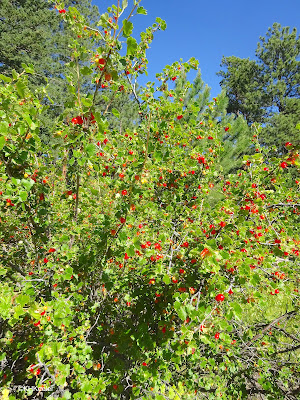 |
| wax currants, Ribes cereum |
In the shade of the trees, an evening primrose remained open in the morning light, probably crownleaf evening primrose, Oenothera coronopifolia (evening primrose family, Onagraceae). Most species open in the evening and are pollinated by moths and in some places, bats. (And bees and butterflies after dawn.) I love discovering one that I had missed in the heat of the day because the flowers were not open. Unlike roses and primroses, whose name they sort of share, evening primroses are an endemic American genus of plants, though they are so attractive that some species have been carried around the world and are garden flowers and weeds on other continents. One, the common evening primrose, Oenothera biennis, is a commercial vegetable in Europe.
 |
| evening primrose |
A lovely place to walk.
Comments and corrections welcome.
References
Ackerfield, J. 2022. Flora of Colorado. 2nd edition. Bot. Misc. 60, BRIT Press, Fort Worth Botanic Garden, TX, Botanical Institute of Texas, USA.
Harrington, H. D. 1969. Edible native platnts of the Rocky Mountains. University of New Mexico Press, Albuquerque, New Mexico.
O'Brien, M. and K. Vail. 2016. Edible and Medicinal Plants of the Southern Rockies. Leaning Tree Tales.
Kathy Keeler, A Wandering Botanist
More at awanderingbotanist.com
Join me on Facebook: https://www.facebook.com/AWanderingBotanist
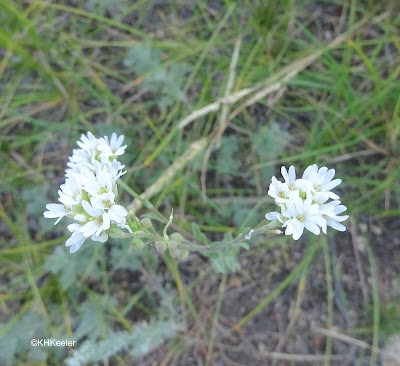

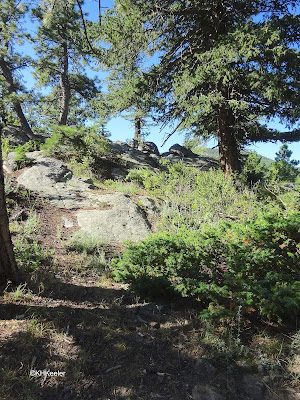


No comments:
Post a Comment